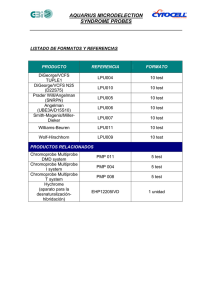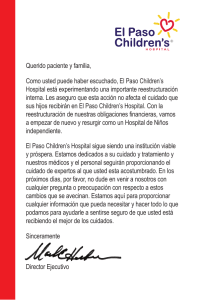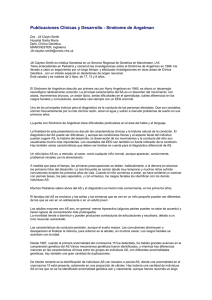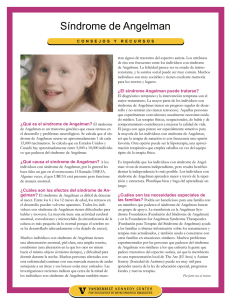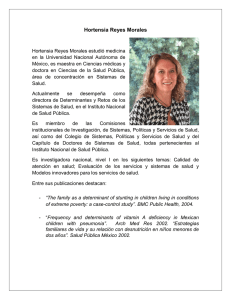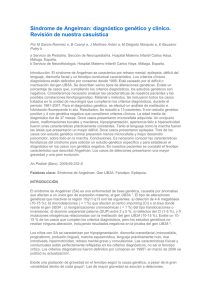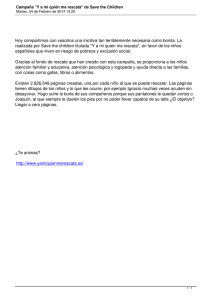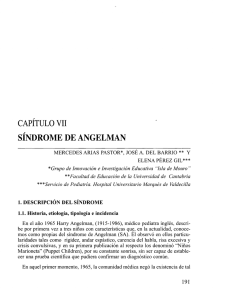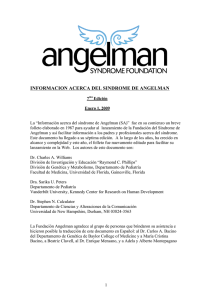¿Quién lo usó por vez primera? Síndrome de Angelman
Anuncio
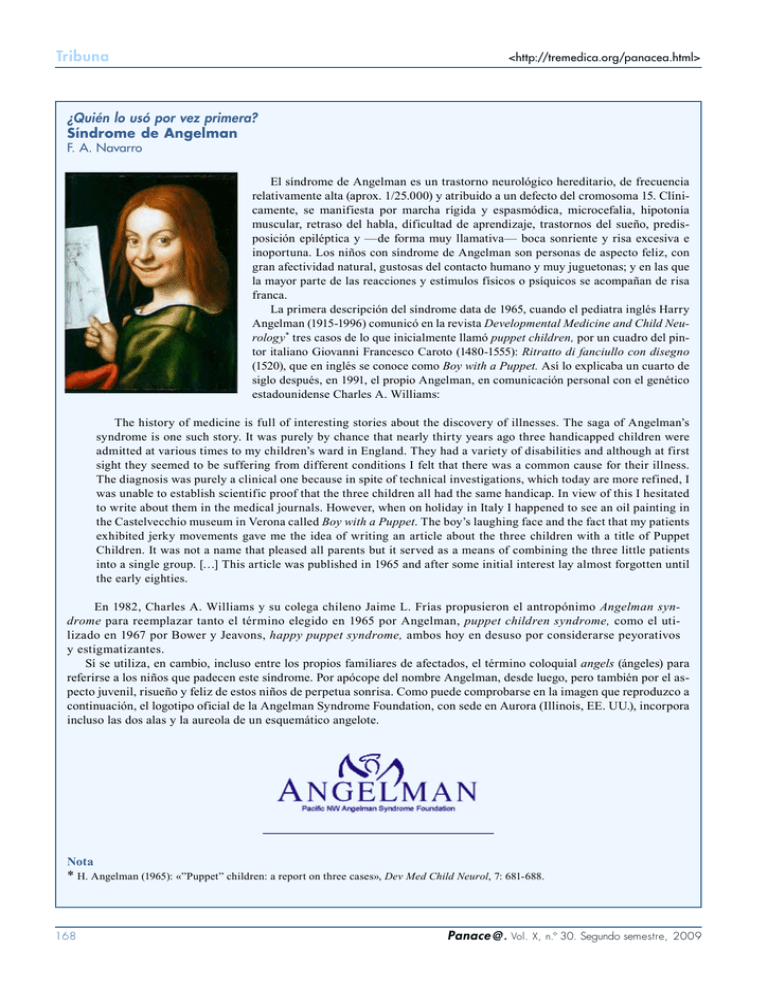
Tribuna <http://tremedica.org/panacea.html> ¿Quién lo usó por vez primera? Síndrome de Angelman F. A. Navarro El síndrome de Angelman es un trastorno neurológico hereditario, de frecuencia relativamente alta (aprox. 1/25.000) y atribuido a un defecto del cromosoma 15. Clínicamente, se manifiesta por marcha rígida y espasmódica, microcefalia, hipotonía muscular, retraso del habla, dificultad de aprendizaje, trastornos del sueño, predisposición epiléptica y —de forma muy llamativa— boca sonriente y risa excesiva e inopor tuna. Los niños con síndrome de Angelman son personas de aspecto feliz, con gran afectividad natural, gustosas del contacto humano y muy juguetonas; y en las que la mayor parte de las reacciones y estímulos físicos o psíquicos se acompañan de risa franca. La primera descripción del síndrome data de 1965, cuando el pediatra inglés Harry Angelman (1915-1996) comunicó en la revista Developmental Medicine and Child Neurology* tres casos de lo que inicialmente llamó puppet children, por un cuadro del pintor italiano Giovanni Francesco Caroto (1480-1555): Ritratto di fanciullo con disegno (1520), que en inglés se conoce como Boy with a Puppet. Así lo explicaba un cuarto de siglo después, en 1991, el propio Angelman, en comunicación personal con el genético estadounidense Charles A. Williams: The history of medicine is full of interesting stories about the discovery of illnesses. The saga of Angelman’s syndrome is one such story. It was purely by chance that nearly thirty years ago three handicapped children were admitted at various times to my children’s ward in England. They had a variety of disabilities and although at first sight they seemed to be suffering from different conditions I felt that there was a common cause for their illness. The diagnosis was purely a clinical one because in spite of technical investigations, which today are more refined, I was unable to establish scientific proof that the three children all had the same handicap. In view of this I hesitated to write about them in the medical journals. However, when on holiday in Italy I happened to see an oil painting in the Castelvecchio museum in Verona called Boy with a Puppet. The boy’s laughing face and the fact that my patients exhibited jerky movements gave me the idea of writing an article about the three children with a title of Puppet Children. It was not a name that pleased all parents but it served as a means of combining the three little patients into a single group. […] This article was published in 1965 and after some initial interest lay almost forgotten until the early eighties. En 1982, Charles A. Williams y su colega chileno Jaime L. Frías propusieron el antropónimo Angelman syndrome para reemplazar tanto el término elegido en 1965 por Angelman, puppet children syndrome, como el utilizado en 1967 por Bower y Jeavons, happy puppet syndrome, ambos hoy en desuso por considerarse peyorativos y estigmatizantes. Sí se utiliza, en cambio, incluso entre los propios familiares de afectados, el término coloquial angels (ángeles) para referirse a los niños que padecen este síndrome. Por apócope del nombre Angelman, desde luego, pero también por el aspecto juvenil, risueño y feliz de estos niños de perpetua sonrisa. Como puede comprobarse en la imagen que reproduzco a continuación, el logotipo oficial de la Angelman Syndrome Foundation, con sede en Aurora (Illinois, EE. UU.), incorpora incluso las dos alas y la aureola de un esquemático angelote. Nota * H. Angelman (1965): «”Puppet” children: a report on three cases», Dev Med Child Neurol, 7: 681-688. 168 Panace@ . Vol. X, n.º 30. Segundo semestre, 2009

